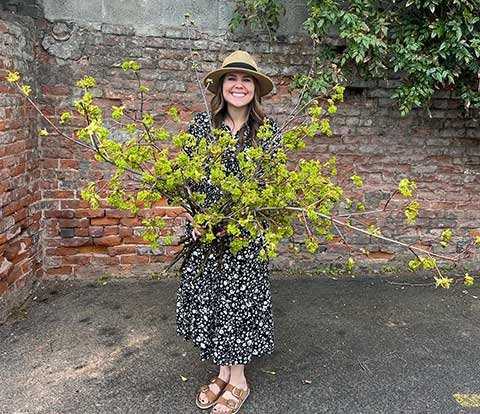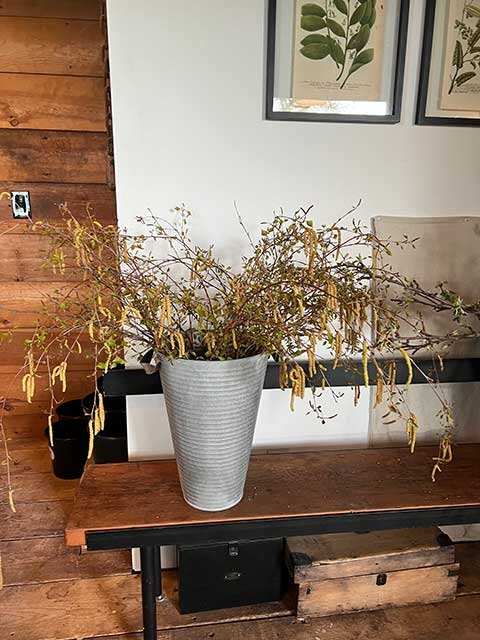How to make spring come early by forcing branches into bloom
At the very end of the winter season, when it seems like it just won’t let go, we are all starved for signs of life outside. For me at least, my impatience for spring at this point of the winter is almost painful.
Bringing branches into the house and forcing them to bloom has been my solution for as long as I can remember. It is such a relief and a joy to watch the delicate blossoms unfurl and perfume the whole house while it is still winter outside. In most cases, by the time my branches have bloomed and faded indoors, they just getting started in the field, so I’m able to extend the otherwise brief time to enjoy them.
I encourage you to give it a try too. You very likely have things growing in your own backyard that you can force for a beautiful spring display - just a tick before spring arrives for real. Here’s how.
Nothing says SPRING quite like an armload of delicate blooming branches.
1. cut the right branches at the right time
Almost all woody branches that bloom can be forced. But it is important to cut them when the buds are really swollen and just about to open on their own. If you cut them too soon, before the plant has broken its own dormancy, they won’t open. You can experiment with different branches cut at different stages of growth and you will quickly learn what works best for you.
Here are a few branches that force beautifully. You probably have access to at least one of them or something gorgeous that is not on this list. Try whatever you have to learn what works.
Wild cherry - these guys are all over the Palouse! I have one next to our flower cooler that I scavenge from every year. It is one of the first branches to get blooming in the house.
If you prune your fruit trees before they bloom, bring the culled branches into the house for a bit and they will put on a show.
Forsythia is one of the easiest to force. I wait until I see a tiny hint of yellow emerging and they’ll open right up for you.
Ornamental Quince is so lovely. If you force it from the bud stage, it will bloom in white. If you wait until it is opening just a little, you will get the more familiar salmon color. Both are wonderful, just cut at the right time to get the color you want.
Crabapples are absolutely gorgeous and there are so many good varieties. They are some of the easiest branches to force and they last a long time.
Mock Orange will fill your home with the most beautiful fragrance. It is a popular landscaping plant, but we also have a lot of its wild cousin, Syringa, around here. Syringa can be forced. But, keep in mind that its bloom is very fleeting. You might get three days from wild Syringa. Honestly, I’ll take that! Three days of delicate blooms and lovely fragrance? What’s not to love.
We have a lot of Wild Hawthorne on our farm that I enjoy forcing. Again, the native plants do not bloom as long as the cultivated versions in our gardens, but they are still lovely and I cut some every year.
Magnolias have a large dramatic bloom and are gorgeous forced indoors. Just be sure the bud is well developed and close to opening for success. Tulip Poplars are in the magnolia family and have an especially beautiful flower that is best appreciated up close. So, bring some of those in for sure.
You can force just about any blooming branch. The one exception is lilacs. They have a habit of stopping their development in whatever stage you cut them. So if you cut bare branches, that’s all you’ll ever get. They. Will. Not. Open.
The same applies when you harvest them in bloom. I love to cut lilacs when only the bottom half of the flower panicle is fully open and the tips are in bud. The texture is beautiful and the partially opened flower looks like growth, movement, and potential to me. If I cut them at that stage, they freeze in place for my arrangement.
Bundles of Wild Cherry cut at exactly the right stage to force
2. Don’t overlook the odd ones
Don’t get too hung up on limiting yourself to branches that make an obvious flower. All trees have blooms of some type. That is how they make their seeds, after all. There are many unconventional ones that are really pretty but often overlooked. Maples make a gorgeous, textural lime green bloom that is beautiful all on its own, but also super pretty mixed with other spring flowers like narcissus.
Birch trees set out beautiful weeping catkins that are also stunning solo, while adding texture and movement to any spring floral design. They are one of my favorites.
Experiment with the trees in your yard and see what unexpected beauty you can uncover.
A beautiful spray of blooming maple branches
3. Process the branches correctly for the longest vase life
Dense woody stems do not take up water as readily as the tender stems of the flowers you’re used to. That is especially true in the very early spring when the plant is coming out of dormancy. Just like I need my morning coffee, woodies need a little help to wake up too.
You will want to expose as much of the stem as possible to water – the little horizontal cut you made when you snipped the branch does not do much.
The answer is to make vertical openings up the stem to increase that surface area exposure and to open access to the capillaries that will carry water to the tips of the branch.
There are two schools of thought on how to do that. The traditional method is to place the cut end on a firm surface, like a sidewalk or a wood stump, and smash it up with a hammer. It’s fun to do and it works.
More recently, florists have been promoting simply cutting vertical slices up the stems with a sharp knife or your snips.
Increase the surface area of larger branches for better water uptake by breaking up the ends with a hammer
My feeling is that it depends on the size of your branch. If you have a thick woody cut, it is going to be hard to slice in with your knife and you’ll open more surface area with a hammer. So smash away on those big branches. For green or smaller branches, you may have better luck with your snip. Experiment and see what works best for you.
Cut slits in your branch ends with a snip if you are able. Again, you are increasing the surface area of the cut end to maximize the uptake of water. Better water absorption will help your branch to bloom and to last longer in the vase.
4. Go for wild abundance for a dramatic statement in your home
Forcing branches is a time to cut loose and be creative. Go big with a generous container and space for the branches to be a bit wild and do their thing. They will make a beautiful focal point in front of your fireplace or in an entrance.
Alternatively, you can put a few small branches in very simple arrangements in places where people can see them up close like on your bathroom counter or on a bedside table.
However you arrange them, I hope you experiment with cutting and forcing some branches in the early spring to invite some flower joy into your home. Most of all, I hope you let me know what you do! I love to see everyone’s arrangements.
Birch Catkins making a statement





